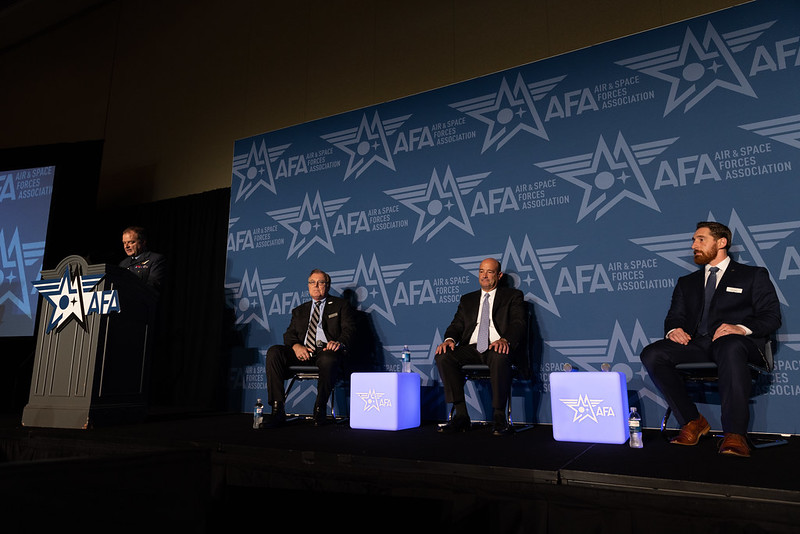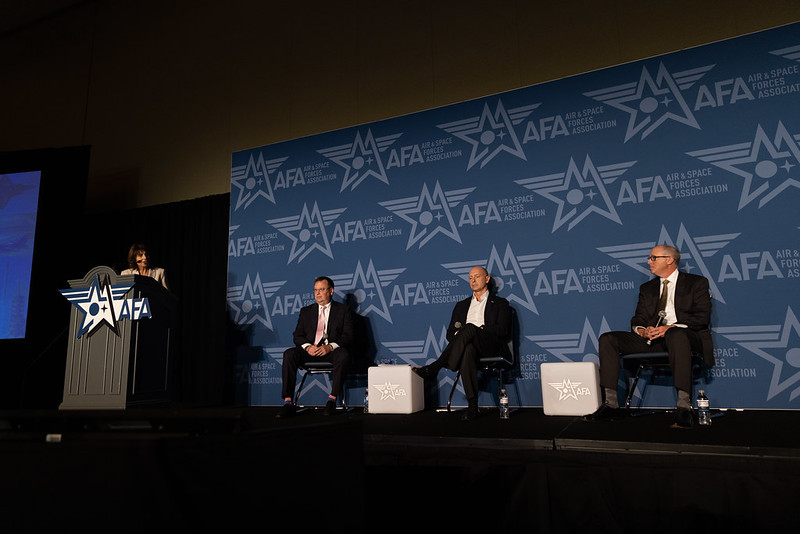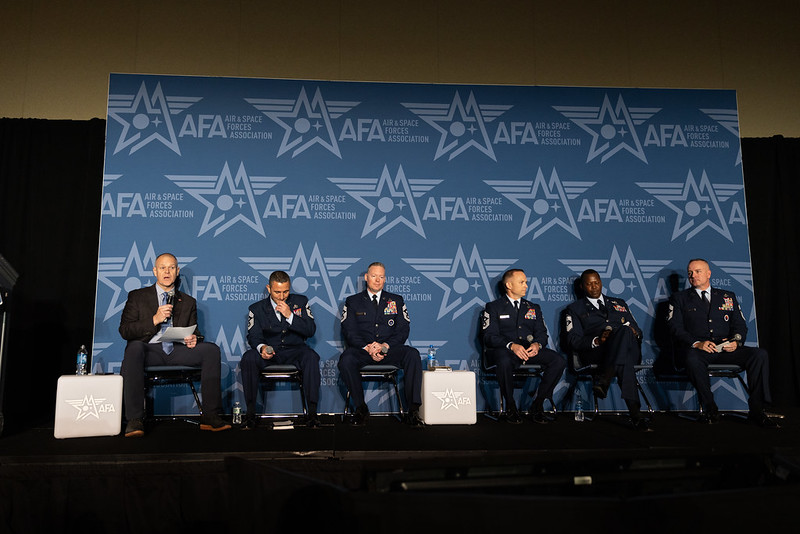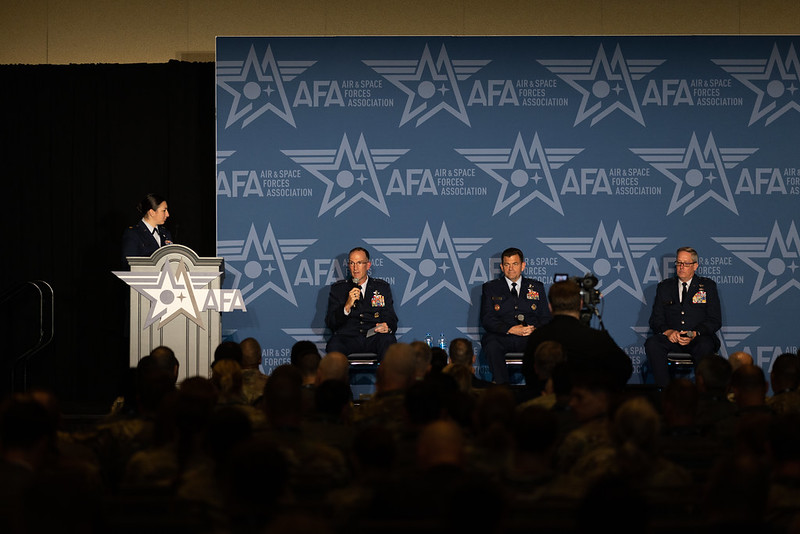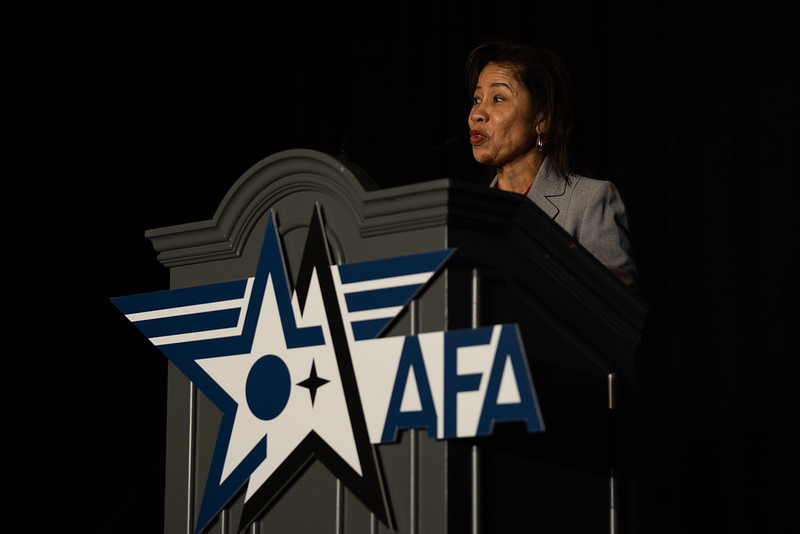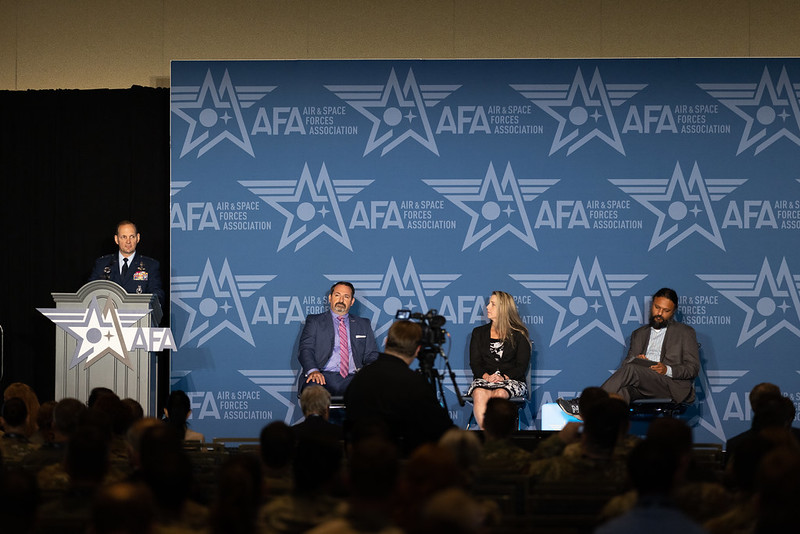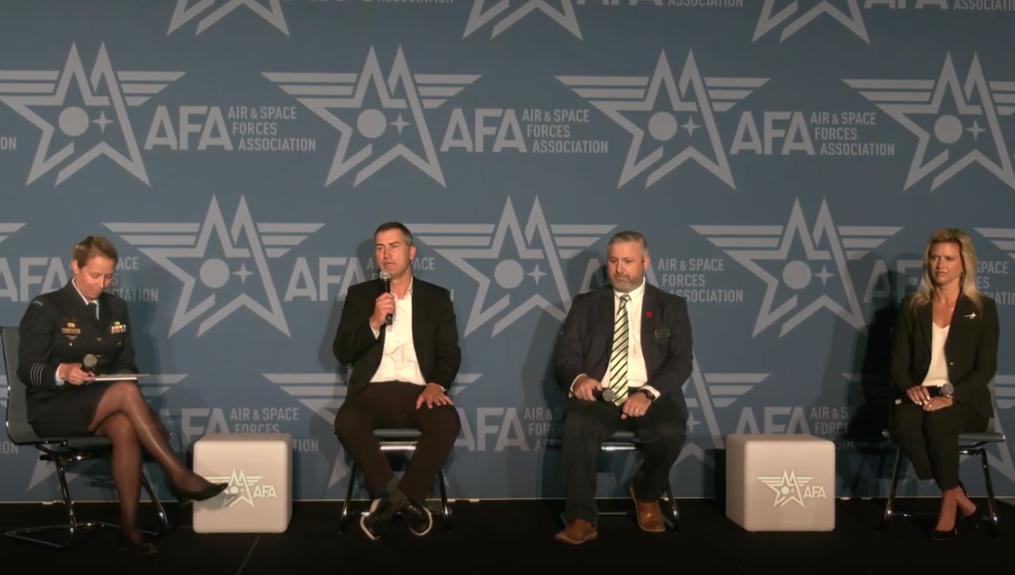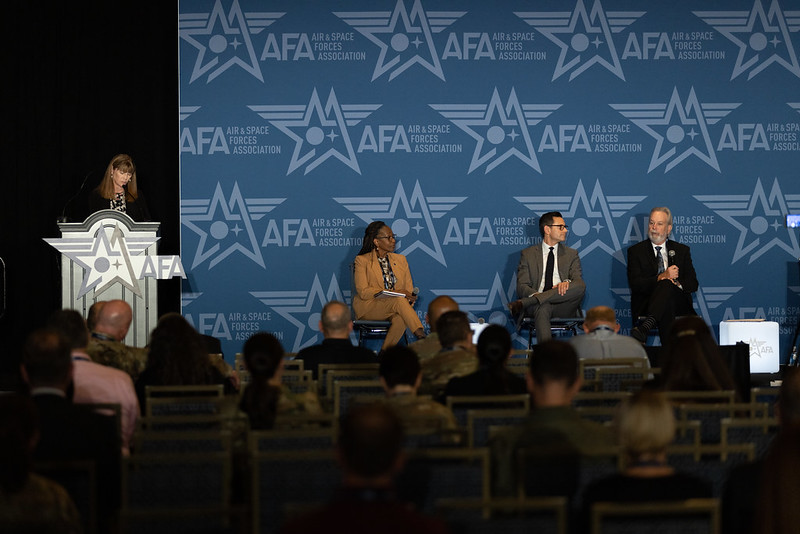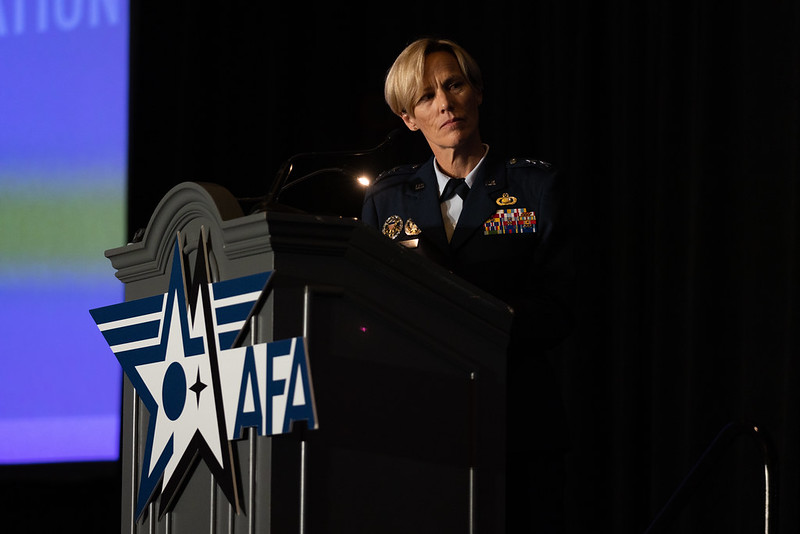Royal Air Force Air Commodore Blythe Crawford moderated a discussion on “Weapons and Munitions” with retired Maj. Gen. Stephen T. “Steve” Sargeant of Marvin Test Solutions, John Martins of MBDA, and Steve Milano of Raytheon Missiles & Defense, Sept. 20, 2022, at AFA’s Air, Space & Cyber Conference. Watch the video or read the transcript below. This transcript is made possible by the sponsorship of JobsOhio.
If your firewall blocks YouTube, try this link instead.
RAF Air Cmdr. Blythe Crawford:
Distinguished guests, ladies and gentlemen. I’m Air Commander, Blythe Crawford, Commandant of the Royal Air Forces Air and Space Warfare Centre. If any of you have a problem with the accent, I’m sure one of the panel will be able to translate on my behalf. But I’m delighted today to welcome all y’all to this panel on weapons and munitions. And the challenges that we are facing with addressing these in the future.
I’ll introduce our illustrious panel in a moment. But by way of introducing the theme, I’ll say a few words just to contextualize the scenario we are faced with today. So, as we gather here this week, the world is facing one of its most turbulent times in history. Since Putin’s letter back in December ’21 where he detailed his aspirations for a new world order. We have seen our adversaries emboldened to take action beginning with the invasion of Ukraine in February.
This conflict will be marked in history as one where a democratic state fighting for its freedom and supported by the free world was faced with invasion from an increasingly autocratic Russia, seizing strategic opportunity, enhanced by a global pandemic, political shifts in the West, and a withdraw from Afghanistan. The first real conflict where Western weaponry has had to directly approve its metal against contemporary, but also supposedly modern Russian weapons.
It has become a lesson tactics, resilience, logistics, and strategy to say the least. Watching with keen interest, the Chinese then sought to reaffirm their claim over Taiwan, escalating a long-term crisis. And where if conflict occurred, we could see an untested but seemingly very capable Chinese force pitted again against Western weaponry. Each of these crises have also forced us to address our resilience and supply chains.
Tom Mahnken recently recorded that the US needs a new approach to producing weapons, where whilst they have played an increasingly important role in halting Moscow’s initial offensive, it has become increasingly apparent that such weapons are neither cheap nor available in unlimited numbers. The effectiveness of precision weaponry against invading forces has been impressive. But has also highlighted the fact that the current US munitions infrastructure is not robust enough to support a high intensity protracted conflict against a major adversary such as Russia or China.
Similarly, our technical advantage looks increasingly vulnerable as both Russia and China test a new range of weapons, hypersonics being a classic example. Though the effectiveness of these in the battlefield is still unproven. We have similarly seen our adversaries conduct trials in space, although not officially weaponized yet. But where they’re showing considerable progress and interest. And of equal consequence, we have seen off the shelf drones with rudimentary munitions take on the vast field of Russian armor with great effect on the battlefield.
So, what does this mean for our force mix of the future? So, these are all challenging problems which must drive us to think and act faster and more effectively than before. Within General Brian’s slogan of accelerate, change, or lose. So, I’m privileged to be allowed to draw on some of the country’s experts in this field, who I’m sure can help us address some of these questions and others. So, I’d like to start by introducing Major General Steve Sergeant, retired, who has been CEO of Marvin Test Solutions since 2012.
General Sergeant previously served as the Commander of the Air Force Operational Test and Evaluation Center, the 56th and 8th Fighter Wings, and was Commandant of the USAF Weapon School. We’ve also got John Snooze Martins, Director of International Programs at MBDA. Snooze served in the Navy flying F-14s as a TOPGUN instructor, and TPS graduate, and as a Program Manager in the F/A-18, F-35, and the Air-to-Air Missile Program Offices.
And finally, Steve Milano, Director of Air-to-Service Effects at Raytheon Missiles & Defense. Steve leads Air-to-service Requirements and Capabilities Development for Raytheon Missiles & Defense Air Power Mission area. And his portfolio also includes various existing weapon systems as well as emerging capabilities like open system architectures and collaborative autonomy. So again, I’m very pleased to welcome such an illustrious panel to the stage. And maybe General Sergeant, would you like to kick off the discussion?
Maj. Gen. Stephen T. “Steve” Sargeant (Ret.):
Well, thanks very much. And I really appreciate two things. One, the warm introduction for all of us. And two, you and all your colleagues from the United Kingdom being here during a very solemn time back home. And we appreciate the sacrifice you make being here at the Air and Space Symposium this week. So, thanks very much.
So, I’m going to spend just a very short time introducing a little bit to play off of what you just talked about, especially with Smart weapons and the speed at which the Air Force and Guardians, but in this case, it’ll be mainly talking about Airmen that are working on the flight line, the speed at which they need to prepare aircraft to be able to deliver weapons. And we’ll see if my clicker works here. There we go.
So, over the last decade that I’ve been on this side of the blue line, on the industry side, and by the way, they’re not all slimy contractors. There are actually a lot of people down on that first floor in the atrium in the exhibit hall that are really here to listen to what your requirements are and try to deliver those in the time that you need them. Just a little plug for some of those that aren’t necessarily aware of that or haven’t maybe wandered down into that hall.
There’s a lot of things to learn and a lot of things for you to impart there. But over the past 10 years, I’ve dealt with a lot of Airmen in the armament arena. And quite frankly, when I was on active duty, they took me out to bend wrenches on the jet now and then. But never really with the armament piece, and seeing all the onerous amount of test equipment that they had.
So, I asked them along the way, “What would you really like?” Things like a small footprint by the jet. In other words, fewer boxes, but more capability in the boxes that they do bring out. Rugged and Airmen-proof equipment that didn’t need to leave the flight line every six months to be calibrated and or fixed, and be gone for sometimes up to three or four months. Reduced training requirements. In other words, they were thinking about Multi-Capable Airmen a long time ago.
And that the speed at which ACE needs to be executed. So, that you could go and be trained across multiple different systems using the same equipment as opposed to the traditional model of every MDS has its own separate set of test equipment. So, commonality was something that they were thinking about, for sure. And not just at home drones, but when they were deployed to other locations. And they really wanted test equipment that would actually do functional test of Smart weapons.
Not using, for the most part, test equipment that was fielded with the current legacy fourth generation aircraft back in the late ’70s that has just been bandaid together, or maybe replaced with a similar light commodity test set on a flight line. I said commodity for a reason, because that’s how it’s looked at in the acquisition world. And so, they had a box that did certain things. They got a new box that did certain things that could be sustained.
So, they looked and said, “Well, do we have to keep going down that road?” And we’d sure like to do faster setup, and faster test times, and be able to keep the data that we have, so that we could use that thinking ahead to what you all are looking at today, how to use AI to do predictive maintenance. This is over the last 10 years. This wasn’t in the last 10 months. And then they really wanted to be able to increase mission effectiveness with reliable equipment and things that could meet the sortie generation times.
Things like combat turns are back again. They disappeared for a long time. So, then enters Agile Combat Employment. And with the work that we had done at Marvin Test Solutions over the past decade, we started having people come around and look at our equipment, and said, “Whoa. You’ve got an Agile Combat Employment or ACE enabler here,” where we’ve taken a lot of the capabilities and put them together moving from the desirements of what the maintainers had on the previous slide, leading to actual requirements that could be written, and actually achieved, and attained.
And so, when we looked at that, we said, “Well, let’s break this out a little further.” Common, menu driven, intuitive type test equipment. And with some of the tests that were done over the past couple of years, Airmen who had never been trained, were selected from the flight line to come over and use the equipment. And they were doing tests in sometimes 90% less time than the traditional equipment, having never been trained on it.
I think that leads to a Multi-Capable Airman, when you can pull someone who’s never been trained on that equipment and use it, which kind of goes along the lines of what the chief was talking about yesterday when General Brown said, “We don’t need to have someone that’s certified, certified, certified, not certified, where we make it very hard.” You can break down the barriers if you have the right equipment.
Unprecedented test times. And then lean support in that as you’re moving multiple MDSs together in these tailored force packages, to be able to have single common test equipment that could test all of them. That exists today. That exists today, and can be moved rapidly with the C-130s that the PAC-AF commander talks about having at his disposal, not C-17s in the future. So, the footprint will be extremely, extremely important.
So, this is what the Airmen have been saying. And this is what we’re listening to and tried to feedback to them. So, if you get a chance, stop by our booth, 716, and we’ll show you some of what they were calling ACE enablers. I’ll leave you with this little bit of maybe fire up since it’s after lunch. A little fire up video, if this all works. Here we go. Something happened. Click. There we go. Let’s see if it’ll play. I’ll hit the click play and see if it goes. Maybe we’ll get the folks over on the side to make it happen. It’s not me. Well, if they can’t do it, maybe we’ll let the next speaker go. And then they’ll come back to it. Thank you.
RAF Air Cmdr. Blythe Crawford:
All right. We’ll have some gratuitous explosions at the end. So, over to Snooze.
John Martins:
Well, sir. I’m also a fan of video. So, what I thought I’d do today is voice over a three minute video of lots of things blowing up. So, hopefully, we’ll pick up the slack a little bit. I’m John Martins, call sign Snooze, from our MBDA D.C.’s office. MBDA is a global weapon manufacturer. We have plants in France, Italy, UK, Germany, Spain, and of course, in the US. Have over 45 weapons in the inventory.
Today, I’m just going to focus on two that are applicable to our toughest theater we’re about ready to look at, and that’s the Indo-Pac Com theater. Of course, the Indo-Pac Com theater is especially stressing because it comes with that anti-access maritime battlefield. So, makes the weapons have to do things like all weather, multiple moving target, against ships that can defend themselves. So, that tends to drive extended ranges. And Smart seekers that can do basically self-contained kill chains.
So, I’m going to use two weapons to highlight that in a three minute video. Ideally, I’ve got to prep the video a little bit because it’ll come at you really quickly. But the only thing I’d love you to walk away with is the message that, and it’s kind of cautiously optimistic, which is the US has a lot of friends throughout the world. So, we don’t fight alone usually. And so, what I’d like to leave you with is the friends are going to show up with some pretty cool stuff, and show up ready to fight.
So, with that, I’d love to jump right into what we call the SPEAR Missile. But it’s in development right now. So, I didn’t have a lot of cool seeker video. But it’s Brimstone is going to give us a good baseline. So, I’m going to show you what I call the world’s most underappreciated direct attack weapon, the Brimstone. For everybody to sync you up, it’s a lot like a Hellfire or a JAGM except it’s been stressed to go on fast-moving fighter aircraft. So, they pull a lot of Gs.
You’ll see there’s a dual seeker on Brimstone. Brimstone has a millimeter wave. So, of course, it can go to Lat Long and take out a piece of metal. It can also take out laser spots. But of course, we’re going to talk about cooler stuff. This is what we do in Huntsville, Alabama. We build the Diamond Back Wing kit for Boeing’s STB-1. Built over 30,000 of them. But what you’re going to see now is Brimstone in the dual mode. Dual mode, this is in the desert against a really fast target. It’s a small target. You see the laser spot is where the crosshair is. Really messy, not on the target.
So, what the Brimstone does is it turns on its millimeter wave radar. It says, “I see what you want me to do.” And it takes over, and end the game. I got another shot against a similar target. Also, a motorcycle clipping along in the desert. And again, notice that the messy laser spot, and it does its thing. Next, I’m going to show you is a column attack mode. A fighter can carry 12 of these a piece. The launcher says, ‘You 12 missiles are going to see the same thing.”
Brimstone one, you go after the first target. Brimstone two, you go after the second. Brimstone three, you go after the third. So, basically a self-contained kill chain. I know you guys are all thinking of Ukraine. This is a great weapon for that type theater. You all have seen the road of trucks. Brimstone also has an area attack mode very similar to the column attack. In this case, it’s an area Brimstone do the same thing. They seek out the targets and kill them.
High res millimeter waves. So, it can tell the difference between track vehicles and wheeled vehicles. Can tell exactly how big the target is it’s going to attack. So, there’s a bunch of different ways you can make sure it doesn’t kill the good guy boat. That was just to prep us for SPEAR. SPEAR, that’s going to be coming up, is we’ve improved Brimstone in almost every way. We put an air-breather turbine instead of the solid rocket motor and wings. So now, on class it goes beyond 90 miles.
Think a tactical cruise missile for those targets that don’t warrant those large expensive cruise missiles, if you will. It’s got a better seeker than Brimstone. So, everything you saw is better on this one. Better warhead as well. And of course, long time of flight, you’re going to need a data link that’s got Link 16. It’s a slow missile. So, there’s also a SPEAR-EW. So, you can stick one of those in an attack package like this to take care of the weapons enroute.
So, we’re going to continue the theme with another air-breather. You need air-breather for a confined stealth space to get a lot of energy in there. In this case, it’s the Meteor Air-to-Air Missile. Of solid rocket motors, have up to 80% volume as oxygen. So, if you can get your oxygen from the outside, you can pack a ton more energy in these things. So, in comparison to a similar sized air-to-air missile, this one will go three times further head-to-head, five times further in a chase down. So, if you have a 50 mile, these are fake dummers by the way, 50 mile head-on shot, would be 150 for Meteor.
So, you can imagine a mixed load. All our coalition partners have the world’s best medium range missile as well, the AMRAAM. So, imagine a mixed load of two Meteors, four AMRAAMs, two AIM-9s to clean up anything that’s still living within 20 miles. So, yeah. You can almost use F-35 and air superiority now in the same sentence. So, with that, I hit you real quick with that. Just hopefully, you guys take away that yeah, the coalition partners have a lot of cool stuff hanging out, and they’re going to show up ready to contribute. Thanks so much for letting me be a part today.
RAF Air Cmdr. Blythe Crawford:
Yep. Thanks, Snooze. And he’s got a brochure as well. Okay. Over to Steve, please.
Steve Milano:
I’ll try and go a little bit quicker I think. Thanks for the overview. I learned a lot actually from this. And I’m really, really humbled to be on the stage with you guys. A lot of experience up here. So, thank you for the invite and thank you for the opportunity here. So, my name’s Steve Milano. I am the Air-to-Ground Effects Lead out of Tucson, Arizona. So, the StormBreaker weapon as well as Joint Strike Missile fall within my portfolio. And I think we have a short video that we’ll play. You may have seen it kind of in the lead up. So, it’ll be a little bit of a recap here. So, if we can roll that video, we’ll be able to get started.
Video:
Air dominance is critical in today’s global threat environment. To stay one step ahead, Raytheon Missiles & Defense is advancing the capabilities of weapons like AMRAAM and StormBreaker. With upgrades to AMRAAM hardware and software to enhance its range, maneuverability, and effectiveness against advanced threats. And the StormBreaker Smart Weapon. Network-enabled to receive target updates in-flight, and readily integrated across a host of platforms. Raytheon Missiles & Defense.
Steve Milano:
See, short videos. It’s not a tip, it’s just a recommendation. So, the StormBreaker Smart Weapon. So, I wanted to lead with that as the stepping off point for a little bit of the conversation that hopefully, we’ll get into here, is that we’ve reached IOC on the F-15E. And we’re in operational testing for the F-35B, A, and C to follow. Obviously, a lot of interest in the capability on those platforms.
But I really wanted to look at what are we focusing on within our air-to-air and air-to-ground effectors? And it’s how do we evolve capability and capacity today? And it’s leveraging our partners from the logistics trains after they’re developed, but also in the design phase. And so, we’ve done a lot of work trying to digitize the life cycle of all of these effectors. And so, looking at the digital twining on the early side is great, and it’s interesting, and it gets us to an ability a lot faster. But that’s just one piece.
And I like to say, “Mind the gap,” right. Because when you go from one stage of the systems engineering V to the next, you’re fraught with peril, right. And so, we’re really trying to focus in on how do we deliver capability without disrupting capacity in the current state? And so, that’s been something that we’ve been focusing on and trying to bring capability, not just to the US war fighter, but partners and allies around the world. And it really is, it’s been an interesting journey because it’s not a single approach.
And as soon as you bring everyone into the fold, you learn a lot more, but you also enable capability across the spectrum. And so, really we’ve been focusing across the air-to-air domain and air-to-ground domain about Raytheon Missiles & Defenses. Really focusing on how do you get to that system integration perspective? And we’ve got a lot of history there. We’ve got a lot of history bringing systems to the forefront. And just bringing those things together, and bringing suppliers, partners into the fray. So, looking forward to the conversation.
RAF Air Cmdr. Blythe Crawford:
Brilliant. Thanks very much Steven. Thanks to all three of yous for some fascinating insights. So, we saw a pretty impressive array of weaponry there, and right across the board. And obviously, with modern weaponry it takes quite a bit of time to produce some of that, and especially at scale. So, if we go back to one of the first points that I brought up concerning our ability to produce and distribute weapons at scale. Is Tom Mahnken right with his assumption? And if that is an issue, how do we get after this, both from a production and a logistics perspective, to be able to produce weapons at the scale they’re going to be used at? And General, would you like to kick off with that one?
Maj. Gen. Stephen T. “Steve” Sargeant (Ret.):
Well, at the Marvin Group, we don’t make anything that goes boom. But you can’t get the boom to the target without the things that come out of Marvin Engineering. In other words, the bomb racks, launchers, and the pylons. And I’ll just give you an example of how you can scale up and move the speed of production when needed. About three years ago, it was discovered that there was an 18 month gap from the time of F-35s rolling off the flight line until the armament actually showed up.
And when the government came to Lockheed, and Lockheed came to the Marvin Group, and they said, “We need your help,” within 18 months they closed that gap from a cold start, ramping up what they had. So, when things need to be done, you look back in history, like we heard yesterday, we’ve done this before. And I would tell you that Marvin Engineering hadn’t done it before. But American industry had with our partners because there are four countries involved in the production of that armament beyond Marvin Engineering. And they made it happen.
RAF Air Cmdr. Blythe Crawford:
Brilliant. Snooze, is this something you’ve looked at, at MBDA as well, just in terms of production times?
John Martins:
Yeah, production times, as well as I think what disappoints the war fighter as well, not only production delivery, but development as well. I know there’s some lingering requirements holds, especially where we want to go fighting. And one of the things that frustrates I think the customer, the war fighter, is that it takes a rough rule of thumb in our businesses, 10 years and a billion dollars to develop a new weapon. And we need them yesterday. And they’re not available yet. So, if there was a way I think if we could accelerate that developmental time.
If you don’t, you’re stuck with what’s available today, or maybe small modifications, or so. But I will plug again the coalition partner theme is we’re not going at this alone. And of course, there’s production overseas and other options available. So, that’s an immediate low-hanging fruit, as well as I’d love us to fix the acquisition community that I grew up in, right. So, I was a part of the problem. But it’s a tough problem, rest assured. And I think we’re looking at a daunting task of a theater that needs capabilities we don’t necessarily have today. And we need a lot of weapons as well. So, it’s all coming together at once.
Steve Milano:
Yeah, exactly.
RAF Air Cmdr. Blythe Crawford:
Steve?
Steve Milano:
Yeah. That’s a great point. And that’s where my head goes to as well is that the stable and dependable requirements and funding help build that resiliency into your logistics and supply chain. And so, we all feel that pressure, whether it’s on the government side of acquisition, or it’s on the defense industry side of acquisition. It is a pain point. It’s something that we can help work together as long as we continue to have that consistent conversation.
But it’s also looking at your capacity and logistics train as a system of systems, right. And I think that all too often we don’t look at the total complexity of the logistics and capacity, and how that plays in. We’re starting to realize it because of the current situation we are in now globally. You look across where your supply chain’s weakest. Where do they need some resiliency built in, where can you build in some of that dynamism, and actually have a benefit to the expenditure of some funds to create that resiliency in the supply chain?
Maj. Gen. Stephen T. “Steve” Sargeant (Ret.):
Part of that resiliency that you just mentioned is actually looking ahead and having the stocks that you need, especially as the Air Force looks at this ACE concept. You can’t just move all these munitions around where you need them. So, I think part of what’s happened in the last year in world events has probably driven the planners to step back and go, where do we need to ensure across the coalition partners as well as across the US the stock piles to be replenished or begun, where they were never filled to begin with?
Because you won’t have time. Given all the challenges, the acquisition system’s not going to change overnight. We heard yesterday with some of the panelists with the startups and that sort of thing, things are moving in the right direction. But that’s taken quite a few years to get moving. And the big acquisition process is not totally that rapid and agile yet. And so, stockpiling to enable to be able to conduct the war wherever you are. Moving airplanes is fast. Moving weapons is not.
John Martins:
Yeah. So. General, you brought my mind to the resource section, both of you guys did, which is there’s very few problems you can’t make go away without by not throwing, throw a little money and you can make almost any problem go away. But now what do you do when you have multiple different areas you have to address? Stockpiles, new weapons. And there is a challenge, right, I guess so.
RAF Air Cmdr. Blythe Crawford:
And we’ve seen quite a few panels today already talking about speeding up the acquisition process. But then also talking about digital design and digitalization across the manufacturing process. If we had to put emphasis on technology or process, which one would you plunk for?
John Martins:
Right, both, if that makes sense. But you did talk about a lot of the things that the acquisition community is going after in a good way, which is why can’t we make these weapons modular? Where if you want to replace the back end, you can do that by simply plugging and playing. And having more of a consistent common architecture that you can mix and match, and play, and maybe mix vendors as well. So, I think the acquisition community is going at it the right way. But it’s a slow process.
Steve Milano:
Yeah, I agree 100%. You have to do both, right. The process can change incrementally, but you can’t wait for the process to change. You have to bring the material solutions to bear and the engineering to bear in the current process. And that’ll help us evolve. And so, those processes can enable us to get the most out of digital engineering, digital acquisition processes, that we’re well entrenched in. But we need to acknowledge where there’s shortfalls. The example that I use is that we’ve got completely digitized factories, right, very low touch points. And we’ve got robots moving equipment around the floor.
And all of our material supply systems are fully integrated. And so, you can see where the material is coming in and out of the factories. And I walk in one day, and I see a whiteboard. And they’re writing in exactly, this is the shift, this is how many were done at this shift. And I was like, “Well, what happened to the digitized board?” It was like, “Well, this is faster.” Okay. Well, that’s where process didn’t really catch up with technology, or they didn’t get it quite read. The technology didn’t get it quite right. And the process needed to amend. And so, we need that flexibility back and forth. And I think the answer again, is both.
RAF Air Cmdr. Blythe Crawford:
Okay. Super. Let’s move on to another thing that I want to address. And I discussed briefly about what China and Russia are doing with regards to new weapons at the moment. Experimentation with hypersonics, which Putin has obviously gone out publicly and said that he has been using. It’s questionable whether they are hyper or not. So, are they really catching up? Or, are they ahead in certain areas? And what are the implications of fielding such weapons on the battlefield? So, Snooze, do you want to kick that one off?
John Martins:
Yeah, sure. So, the hypersonics is obviously an area where we’re expending a lot of resources for good reasons. It’s very hard to defend against something coming in that fast. Of course, there are a lot of challenges I think, which you’re alluding to. When something’s going that fast, not only materialize, but communicating sensors on the weapon, or so. So, it is yet to be seen how effective those weapons are. And maybe equally as important, is countering those weapons and having the technologies to do that.
But rest assured, we in the industry side and the acquisition side, we do tend to occasionally fall asleep at the wheel. And we wake up, and we find, “Huh, how come they have this and we don’t have that?” And the good news is we usually respond pretty quickly. I think we did a couple years ago. And hopefully, and almost always those gaps do close. But to answer your question, it’s unclear how effective those are going to be. But it is a problem that we have to address. And oh, by the way, why don’t we have a better arsenal, is the question that we’re all asking as taxpayers?
Steve Milano:
Yeah. And I’ll say it brings to the forefront the necessity for a layered defense approach, right. We understand the threat that hypersonic weapons present, offensive hypersonic weapons present. And that’s leading to I guess a lean-forward approach from the missile defense industry, from the Air Force, from a resiliency in that space-based sensing layer as well as domestic and indigenous missile defense capabilities against hypersonic threats.
But the ability to sense them, the ability to engage them, is critically important. But it also tips the hand a little bit, right. I mean, all of those tests show what’s in play. And physics are what they are. And so, it’s a good tell to be able to see what’s happening on the world stage, what that development looks like. And so, I don’t necessarily personally, me personally, I don’t see it as incredibly alarming when I see a news article. I see it as a data point. And are we responding appropriately? Are we using that calculus to adjust our approach from an offensive and defensive capability perspective? It’s not a one-off. Do we match capability for capability? It’s a balance.
Maj. Gen. Stephen T. “Steve” Sargeant (Ret.):
I think the good news that we tend to overlook is that 12 to 20 years ago we had a lot of work going on in hypersonics. And then for a period of time, leading up to just a couple of years ago, that was put on ice. But we learned a lot over that decade-and-a-half, or so ago on hypersonics. Now that there’s emphasis back on it, we’re not starting from a cold start.
And I think it is an unknown as to how capable the China and the Russian hypersonic weapons are. But the fact is they are exploring that arena. And they’re actually using some of those weapons today. And so, I think we’re going to find with the entrepreneurial spirit of the United States across small and large industries, that there’s a lot of work being done. And I think we will catch up and accelerate past wherever anyone else is today, sooner than later. Working across with our partners and coalition partners as well, who are also working in that arena.
RAF Air Cmdr. Blythe Crawford:
Great. Well, that’s reassuring at least. We talked about hypersonics. But what else would you see as being a disruptive capability that’s potentially around the corner and with regards to weapons and munitions? Steve, do you want to kick that off?
Steve Milano:
Yeah. So, I guess in the cyber domain and in the networked autonomy domain where we’re leaning forward, the things that we’re seeing from a mass scale, it’s all about data and how fast can you process that data. And there’s a lot of areas around the world, there’s specifically our adversaries in China, they have an ability to source data at a greater scale. And so, we really have to look internally and think about where are we applying our resources? Because we’ve got brilliant people in this country and in our partner nations that can come up with those algorithms that can be deployed in our systems-to-systems to really make the capability eye watering.
But it’s only as good as the data that we can feed through it. And so, we need to be innovative about where we come up with those data sources. If it’s a munition, we’ve got terabytes, upon terabytes, upon terabytes of data, of flight testing, between our companies that we can bring to bear. Are we using that appropriately? And so, that’s the area that concerns me the most is are we applying all of our resources to this autonomy challenge? And are we keeping pace? Because it’s less clear than a hypersonic weapon. It’s a little bit of a nebulous space.
John Martins:
Carrying that theme further, our processing power is crazy right now, and our ability to crunch data and deal with data as well. An area that I think could be a game changer is making the weapons through the hard work. The missile we showed you, the Brimstone, had a 700 combat shots and a 98% success rate, which means it’s air crew proof, right. And I think we need more of that. Meaning the weapons, the UAVs, the autonomy. It just simply can think faster. The technology exists to think faster and make better decisions, if we program them right.
Maj. Gen. Stephen T. “Steve” Sargeant (Ret.):
I think it’s fair to say that force-on-force is not what we’re going to face tomorrow. And asymmetric type threats and attacks are certainly there. And so, in the cyber arena, things that were taken for granted that we don’t have to worry about it in the past. Any software that gets there anywhere near a flight line, or a missile site, or satellite production area, all that software needs to be NIST certified. And if it’s not today, it needs to be tomorrow. Because a lot of disruption can happen through software attacks. Whether a traditional cyber attack that we read in the Wall Street Journal, or something that happens with someone on a flight line that she never suspected would happen, like a Twin Tower attack.
RAF Air Cmdr. Blythe Crawford:
As if by magic, General, you’ve perfectly segued into my next question, which was going to be around that asymmetric aspect. We talked a little bit about Ukraine earlier on, which you’re seeing a very different use and very different approach by both sides in that conflict. So, what lessons would you say we are garnering from that battle so far with regards to precision versus mass, or delivery versus effect, for example?
Maj. Gen. Stephen T. “Steve” Sargeant (Ret.):
Well, I think they got my video working, and it might be a good introduction.
RAF Air Cmdr. Blythe Crawford:
Let’s watch some stuff blowing up. Just to revitalize everyone.
Maj. Gen. Stephen T. “Steve” Sargeant (Ret.):
So, one of the biggest lessons learned, did you get the video working?
John Martins:
Can we see it?
Maj. Gen. Stephen T. “Steve” Sargeant (Ret.):
All right. There we go.
John Martins:
There we go.
Maj. Gen. Stephen T. “Steve” Sargeant (Ret.):
Let’s go ahead and hit play on that. This is why you don’t want to mass armor on a road. Just wait for it. We’re not done yet. Now we’re done. But this is why you don’t want to mass armor on a road. And what did everyone fear in Ukraine? The mass of armor. It’s all moving to the south. Well, with some of the weapons from the gentleman to my left that were employed and weapons from others, that column became one of the world’s largest targets at the time.
John Martins:
Yeah. So, question asymmetric type piece. And yeah.
RAF Air Cmdr. Blythe Crawford:
Yeah. So, mass versus precision and delivery versus effect. We’re seeing grenades being dropped through the turrets of tanks from a commercial drone that’s [inaudible 00:36:00]-
John Martins:
Right on. Yeah. So, we’re making incredible advances in the areas that we’re talking about. And we’re becoming reliant on it. So, it’d be real easy to, if you can take away some of those tools, we’re starting to rely on the computer power. Computers are self-targeting, that sort of thing. And sometimes, something as simple as a gun can do some neat work. And it’s hard to be full-
Maj. Gen. Stephen T. “Steve” Sargeant (Ret.):
Or a Javelin.
John Martins:
There you go, a Javelin.
Maj. Gen. Stephen T. “Steve” Sargeant (Ret.):
Or, a Stinger.
John Martins:
There you go.
Steve Milano:
Yeah. Thanks for the plug there. Javelin and Stinger are doing the job. And it’s a great stepping off point from where my thought process goes on this topic, is that we’ve got existing capability that’s being used in novel ways. And that innovation and that approach is necessary on the battlefield. And so, you’re seeing a lot of the systems that would be quote, unquote, legacy systems being used in new ways. New ways that we didn’t anticipate that they’d be used. But that’s what warriors do. We innovate. When the need is there, we get the job done with the tools that we have.
And so, what that brings me to is when we look at the digital engineering infrastructure, and what that’s doing to accelerate capability to the field, and accelerate development and production timelines, it’s also giving you the flexibility and the modularity to be able to scale up and scale down. Because in one fight you may need that exquisite capability to be able to survive, and get to the threat, and eliminate it. And in another, you may be planking tanks on a 40 mile convoy, and you don’t need that same capability.
So, you want to know what is your cost effective way of doing that. And if you’ve engineered a solution that you can scale up and scale down in the same form factor and you can put that together on the flight line, that’s capability that’s going to endure because it grows with the mission set.
RAF Air Cmdr. Blythe Crawford:
Thank you. And as we enter our last couple of minutes here, just one final question for a quick response to, if I may. We’ve talked about a lot over the last day-and-a-half about integrated by design. And interoperability is a key factor with this. And we’ve seen lots of different western systems being strapped to Ukrainian aircraft at the moment. If we want to get after integrated by design from a weapons system perspective, how do we go about getting after that issue and get some commonality across allies and partners? General.
Maj. Gen. Stephen T. “Steve” Sargeant (Ret.):
There’s probably some lessons from the past that are worth pulling up again. And that was an exercise that was held throughout NATO in the ’80s called Ample Gain where aircraft would move from one base where they were assigned to another base with total different Airmen from another country being able to maintain, gas them up, and load weapons.
Well, in order to do that, you’ve got to get away from multiple different sets of test equipment because this is not affordable in today’s world. So, if you can actually get to common, expandable well into the future test equipment, whatever weapons come up tomorrow, can be tested today and in the future. And that’s one way to do it so that you make Multi-Capable Airmen across the coalition, not just in your own Air Force.
RAF Air Cmdr. Blythe Crawford:
Snooze?
John Martins:
Common platforms as well. F-35, almost everybody’s flying that on the good guy side or so. So, the weapons, even coalition weapons going in Block 4 or so. It’s another way we show up and you just know what the other folks are doing and thinking.
Steve Milano:
Yeah. I have to agree that the common test equipment, common logistics train, it’s very important. Once we field our weapons, if you have a unique logistics footprint that you’re needing to adapt to, that’s a very challenging thing for us as a contractor to be able to plan for and help work with to satisfy your mission space.
But also, commonality across wave forms, commonality across interfaces, UAI compliance is a big thing. So, having F-35 is big. But across multiple platforms is also important as well. And so, if there’s some commonality and discussion points to be able to drive towards common wave forms, common interfaces.
RAF Air Cmdr. Blythe Crawford:
Brilliant. And thank you very, very much gentlemen for a fascinating insight into the future challenges we have with weapons and munitions. It’s encouraging to hear that you’re thinking ahead, and we’re we’re going to be doing something about it to stay at the front end of our game. So ladies and gentlemen, if you’d like to join me in thanking the panel for a fascinating conversation.

